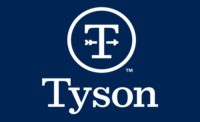Tyson Foods Inc. reported its results for the second quarter of its fiscal year. Second-quarter sales were $8.3 billion, up 3.4% compared to last year, while operating income was $302 million, down slightly from last year's $303 million. Net income increased $10 million to $166 million for the quarter and $322 million for the first half of the fiscal year.
Tyson was one of the companies affected by the “pink slime” controversy, where some consumers and media personalities protested lean finely textured beef for its processing techniques. The controversy "temporarily destroyed demand for ground beef and beef in general virtually overnight," said Jim Lochner, Tyson's chief operating officer. He said that caused a rapid decline in cattle prices.
"Personally, I don't recall a revenue decline that steep," Lochner said.
"Our multi-protein business again proved advantageous, producing solid earnings for the fiscal second quarter," said Donnie Smith, Tyson's president and CEO. "We were pleased with the rate of improvement in our Chicken business. The Chicken, Pork and Prepared Foods segments all were in or above their normalized operating margin ranges, while Beef essentially broke even despite extremely challenging market conditions.
"We're positioned for another great year as we expect to gain momentum in our third and fourth quarters," Smith said. "We still think we have the potential for earnings per share of $2 for the year if we execute as planned."
Tyson said that in fiscal 2012, overall domestic protein (chicken, beef, pork and turkey) production is expected to decrease. Because exports are likely to remain strong, the company has forecast total domestic availability of protein to be down 2-3% compared to fiscal 2011, which should continue to support improved pricing. The company gave an outlook for each of its protein segments, as well as its overall sales estimates for 2012:
-
Chicken - For fiscal 2012, we expect industry production will decrease approximately 4% from fiscal 2011, which should allow for the continuation of improved market pricing conditions. Current futures prices indicate higher feed costs in fiscal 2012 compared to fiscal 2011. We expect to offset the increased feed costs with pricing and mix improvements as well as operational efficiencies expected to result in additional savings of $125 million in fiscal 2012. Our Chicken segment returned to its normalized operating margin range in the second quarter of fiscal 2012, and we expect results to remain strong for the remainder of the year.
-
Beef - We experienced a decrease of fed cattle supplies of approximately 5% in the first six months of fiscal 2012 as compared to fiscal 2011. However, we expect to see an increase in fed cattle in the second half of fiscal 2012, which would result in a total decrease of fed cattle supplies of 2-3% for fiscal 2012 as compared to fiscal 2011. Although we generally expect adequate supplies in the regions we operate our plants, there may be periods of imbalance of fed cattle supply and demand. We anticipate beef exports will remain strong in fiscal 2012. While our Beef segment remained profitable for the first six months of fiscal 2012, we were challenged by volatile market conditions and reduced demand for beef products, which made it difficult to pass along increased input costs. The difficult margin conditions we experienced in the second quarter of fiscal 2012 continued into the early part of the third quarter, but we expect them to recover throughout the remainder of the of the second-half of the fiscal year due to improved cattle supplies and typical seasonal demand. For fiscal 2012, we believe our Beef segment will be profitable, returning to our normalized range in the fourth quarter of fiscal 2012.
-
Pork - We expect hog supplies in fiscal 2012 to be up 1-2% compared to fiscal 2011 and to be adequate in the regions in which we operate. Additionally, we expect pork exports to remain strong in fiscal 2012. While we expect results should be above our normalized range for the fiscal year, we do not expect the remainder of fiscal 2012 to be at our first six-month levels.
-
Prepared Foods - We expect operational improvements and increased pricing to offset increased raw material costs. Because many of our sales contracts are formula based or shorter-term in nature, we are typically able to offset rising input costs through increased pricing. We expect results should remain within our normalized range for the balance of the fiscal year.
-
Sales - We expect fiscal 2012 sales to approximate $34 billion mostly resulting from price increases related to decreases in domestic availability of protein and rising raw material costs.
Source: Tyson Foods Inc.


Report Abusive Comment